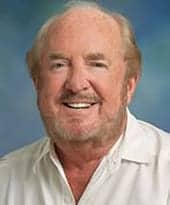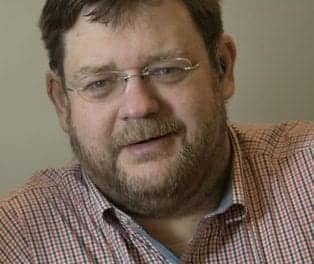Inside the Research | October 2022 Hearing Review
Recent FDA trial approval for their cochlear implant device, Acclaim®
By Kathryn Sutherland
Sutherland: How does the Acclaim work, and what sets it apart from other cochlear implants currently on the market?
Lucas: At its core, the Acclaim is a cochlear implant. For all intents and purposes, the basic mode of operation is what you know to expect from a cochlear implant. It takes sound from the user’s environment. Turns that sound energy into an electrical signal that can be processed and coded by the product and then sends that electrical signal to the electrode array, which electrically stimulates the hearing nerve via structures in the cochlea. What clearly differentiates it from other cochlear implants can be summarized in two parts.

First, the Acclaim is a fully implanted cochlear implant. Meaning there are no externals that the user must wear to pick up and/or process sound. It is truly fully implanted. Second, Acclaim does not use a microphone to pick up sound. Instead, it uses a sensor to pick up sound energy directly from the ossicles. Therefore, the Acclaim is designed to allow the user to benefit both from having their natural ear be the “receiver” or “microphone,” if you will, and from not having externally worn components, which may impact real-life activities or quality-of-life considerations. Obviously, we’ll need to run our clinical trials to determine if any of these theoretical benefits bear fruit, but we are cautiously optimistic. Other design details may also help differentiate us, but we should probably wait for future updates before discussing too much of that in detail.
Sutherland: How is the Acclaim different from the Esteem middle ear implant?
Lucas: They are different products with different modes of operation designed to address different clinical populations. The Esteem received FDA approval in 2010, but the Acclaim remains an investigational device that cannot be commercially sold anywhere and is just beginning its clinical trial journey. The Esteem is a fully implanted, active middle ear implant designed for people with bilateral moderate-to-severe sensorineural hearing loss with aided word recognition scores above 40%. There are other indications and contraindications, but that gives a broad picture of the candidate population. The Esteem uses our sensor to pick up sound energy from the ossicles that it then processes before translating these signals into vibrations that mechanically stimulate the cochlea. There’s no electrode array or electrical stimulation. Esteem is a wonderful product that could help many more people, but we had challenges with market adoption primarily due to the lack of insurance reimbursement for middle ear implants, which is a whole other topic that maybe we should talk about another time.
I would add that cochlear implants are generally covered by both public and private payers, so we believe the Acclaim will have coverage as it is undoubtedly a cochlear implant. We’ll hopefully avoid that market adoption issue with Acclaim.
Sutherland: What are the next steps in the FDA approval process?
Lucas: The Acclaim is a Class III medical device that will require premarket approval by the FDA before it can commercially be available in the United States. We do not know the timing and would not want to guess, but it is certainly several years away. I should add that it is an investigational device that is just starting its clinical trial process.
The breakthrough device designation we received allows us to proceed more efficiently with the FDA. In essence, the program allows for more interaction and slightly faster review times in some situations for the prioritization of submissions. We are also taking advantage of the Early Feasibility Study or the EFS program through the FDA. This program essentially allows us to do our first-in-human implant here in the US at one of the leading centers in the world, Mayo Clinic, which happens to be in our backyard. We commend the FDA for creating these programs to responsibly move product innovation along in more efficient ways. Creating a medical device from scratch, as you probably know, is not for the faint of heart – it takes a long time and costs a lot of money. We believe these programs are trying to help reduce that burden for new ideas.
Sutherland: What role does Mayo Clinic play in your study?
Lucas: Mayo Clinic in Rochester, Minn, is the sole center for our early feasibility study. We are working with Dr Colin Driscoll as the implanting surgeon and primary investigator and Dr Aniket Saoji as the co-investigator and audiologist. Both sit on Envoy Medical’s Cochlear Implant Advisory Board with some other wonderful individuals who have been instrumental in providing excellent advice along the way. And I will say, as a Minnesotan and a Minnesota company with strong ties to the state, there is something significant about doing our first surgery at Mayo Clinic in Rochester.
Sutherland: We know penetration rates among adults who qualify for cochlear implants are low. Do you believe that to be the case, and how might a fully implanted cochlear implant impact those rates?
Lucas: Yes, I believe that cochlear implant penetration rates among adults are quite low. I believe they’re in the single digits, and there have been some publications to that effect in the last several years. I would say that the hearing industry, in general, has a long and documented history of difficulties getting everyone who should address their hearing loss a proper solution that works for them. It’s incredibly unfortunate, as untreated hearing loss has real consequences that we are just starting to understand.
There are many theories on why adults who could benefit from implants do not pursue them. Some more popular considerations are access to healthcare in general, awareness of hearing loss, and understanding that cochlear implants exist. And, of course, there are concerns related to the externals, such as stigma and impact on daily life. My personal belief is that it’s a combination of things, and there’s no silver bullet. More innovation in the cochlear implant industry should help bring more people to their audiologist’s office asking for a hearing test. If we are all good stewards of those patients, that should result in more people pursuing cochlear implants. The Acclaim is designed to have some attractive features we believe people would like to see, which should help bring more people into the cochlear implant arena.
Sutherland: What should physicians, audiologists, and other healthcare providers be doing to get more people to address their hearing loss?
Lucas: First and foremost, they should require hearing loss be taken more seriously by their peers in healthcare. It continues to amaze me how few people outside of the hearing loss industry have a basic understanding of hearing loss and the options available to treat it. Second, they should require more from their politicians. People talk about hearing loss as an invisible disability, making it easy to ignore. Part of that is on us for doing a poor job of communicating cohesive messages to the government. There are many competing interests within the hearing industry, but we should all agree that more patients having more access to quality care and innovative technologies is a good thing. And then finally, I would suggest that hearing healthcare professionals should not just accept the status quo. Competition and innovation are good things that ultimately result in more patients being treated for hearing loss and living better lives.
Sutherland: Is there anything else that you would like to add?
Lucas: Yes. We are hiring and hope to be opening more positions regularly. I would encourage folks to follow Envoy Medical on LinkedIn and keep an eye on our website for updates.
Citation for this article: Sutherland K. Envoy Medical: Interview with CEO Brent Lucas. Hearing Review. 2022;29(3):30-31.




